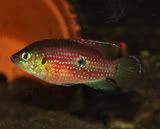- Messages
- 10
what is the max you should go for lowering ph for breeding apistos?
and what would the gh be for keeping to ph stable?
thanks for the help
trev
and what would the gh be for keeping to ph stable?
thanks for the help
trev
I believe pH shock is a myth. We have a friend down here in Florida who is a water chemisty expert. He has worked with the Shed aquarium and several of the aquarium product manufacturers. What I have learned from him is that fast changes in hardness is what causes the problems and that changes in pH are not an issue. I have also heard this from other people who claim to experts and have not seen any evidance that proves them wrong. I really have not seen to many cases where you really need to drop your pH for the fish and I adjust my hardness for the species I'm working with and let the pH go to where it wants to. I just think most people are spending to much time and adding to many chemicals needlessly to their tanks just to maintain a pH level they think they need. How many species really need a pH of 5 or lower. We have to be carefull not to confuse soft water with acidic water because they are not the same. Your RO water with level out to a pH of 7.0 without adding any chemicals so it is two different things. I just mix my Ro with tap untill I get about 80 us hardness and don't care about the pH. I have been breeding P. signatus with perfect sex ratios this way and have not had any problems spawning any my fish. IMO most of the fish we talk about here need soft water and don't really care if the pH is 6, 6.5, 7 or 7.5. For years people have been breeding discus and apistos down here with tap water that has a minimum pH of 7.8 and a moderatly high hardness. Of coase this is what works for my friends and me down here, just my 2 cents worth.
Uwe Romer and Wolfgang Beisenherz studied the effect of temperature and
pH on 33 species of Apisto fry and found that during the first month of
development low temperatures (below 76 F -- the "cool" test tanks were 74
degrees) produced more females. Low pH (5.5 and below) produced more
males, but had less influence. If you want balanced sex ratios, try to
keep your tanks at 76 degrees during the first month of fry development.
That may be a challenge in Florida.
i have had some fish that while they would spawn readily in harder higher ph water
the eggs just would'nt hatch unless i used soft,acidic water(a natural bactricide)
